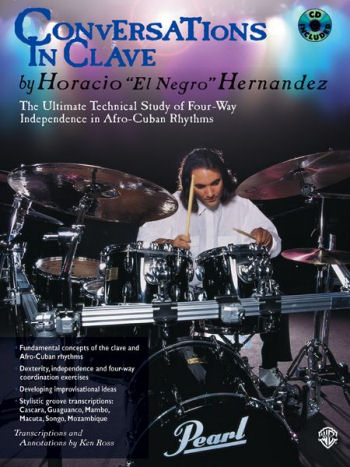
Tiger Bill Reviews
Conversations in Clave:
The Ultimate Technical Study of Four-Way Independence in Afro-Cuban Rhythms
By Horacio "El Negro" Hernandez
Book and CD
Learn to Hear
El Negro tells us that coordination is more than just playing patterns, it's the ability to "hear
multiple rhythms from multiple sound sources at the same time. This is, in fact, the key to high level drum
set and percussion performance." I heartily agree. Although in the beginning you need to practice certain
patterns to be able to develop four-way coordination, eventually you should get to the point where you can
play absolutely anything that comes to mind. To that end, this book is divided into eight main sections and
includes a 65-track audio CD. Let's check out each section, one by one.
Part 1: Fundamental Concepts of the Clave Rhythm
This section teaches the four basic clave patterns in Cuban music. It also explains the combination phrasing
that El Negro plays so well (switching from four feel to six feel). This section breaks down these patterns so
you can easily understand and practice how to superimpose duple and triple meter over an ostinato clave
pattern.
Part 2: Achieving Dexterity With the Clave Rhythm
This section is further subdivided into two main sections:
1) Technical Exercises: Rhythmic Permutations with the Rumba Clave - Includes exercises to develop your coordination and musical phrasing. The clave is played with the right hand, hi-hat is played with the foot on the initial downbeat of each measure, and they're both played against left hand variations (using one-note to seven-note patterns). Reversing the hand parts around is also recommended.
2) Creative Exercises: Melodic Permutations with the Rumba Clave - Contains examples of how to treat the clave rhythm as a melody and play it using different sound sources.
Part 3: Fundamental Concepts of the Cascara Rhythm
This section covers the cascara, which is the basic "ride" pattern in Cuban music. In a percussion
section, this pattern would usually be played on a timbale shell but drum set players could play it on a drum
shell, cowbell, cymbal bell, etc.
Part 4: Achieving Dexterity With the Cascara Rhythm
This section follows the same structure as Part 2 except that it uses the cascara rhythm.
1) Technical Exercises: Rhythmic Permutations with the Cascara - Includes exercises to develop your coordination and musical phrasing. Cascara is played with the right hand, the hi-hat is played with the foot on the initial downbeat of each measure, and they're both played against left hand variations (using one-note to seven-note patterns). It's also recommended to reverse the hand parts.
2) Creative Exercises: Melodic Permutations with the Cascara. Four options are given for practicing this section:
- Right hand plays rumba clave while left hand plays melody.
- Left hand plays rumba clave while right hand plays melody.
- Right hand plays cascara while left hand plays melody.
- Left hand plays cascara while right hand plays melody.
3) Applications In Improvisation: This new subdivision gives you examples of how to improvise both the rhythmic line and the melodies.
Let's talk a look at the remaining four sections of the book.
Part 5: Fundamental Concepts of Afro-Cuban 6/8 Clave
This section follows the same structure as the prior clave and cascara sections except that it concentrates on
the Afro-Cuban 6/8 clave.
1) Technical Exercises: Rhythmic Permutations with the Afro-Cuban 6/8 Clave - Includes exercises to develop your coordination and musical phrasing. Afro-Cuban 6/8 clave is played with the right hand, the hi-hat is played with the foot on the initial downbeat of each measure, and they're both played against left hand variations (using one-note to five-note patterns). Reversing the hand parts is also recommended.
2) Creative Exercises: Melodic Permutations with the Afro-Cuban 6/8 Clave - Four options are given for practicing this section using two of the most common Afro-Cuban 6/8 Clave patterns.
3) Applications In Improvisation: This subdivision gives you examples of how to improvise both the rhythmic line and the melodies.
4) Variations for 6/8 Rhythms: Variations of cowbell ride, bass drum, and hi-hat patterns for 6/8 rhythms. It's also recommended that you apply these to all of the previous exercises in this section.
Part 6: Advanced Systems
Introduces three- and four-limb ostinato patterns with a variety of rhythmic combinations, divided into 3
basic subsections:
1) Technical Exercises - Consists of preparatory patterns and combinations that will give you the coordination required to perform the more advanced exercises that follow.
2) System Exercises - Contains 15 examples of applying left hand variations to various ostinato hi-hat, bass drum, and right hand patterns.
3) Creative Exercises - The final part of this section gives you some tips on applying what you've learned in a musical way and shows you how to combine the previous 15 System Exercises with Melodic Exercise Master Sets (shown later in Part 8) for a thorough coordination study.
Part 7: Groove Transcriptions
These are transcriptions of some of Horacio's patterns offered as examples to help you develop your own
grooves. Includes: 6/8 grooves for the drum set, Guaguanco, Mambo, Congo and Comparsas, Cascara, Macuta, Cha
Cha Cha, Merengue, Songo, Mozambique, and a couple of grooves transcribed from recordings. Horacio explains
that you should not "copy the grooves and leave it at that. You'll never reach your maximum potential as
a player if you do not develop your own voice and style." Excellent advice.
Part 8: Supplemental Materials
The final section of the book is divided into three subdivisions, as follows:
1) Left-hand Variations: Master Sets - All variations, from one- to seven-note, are reproduced here for convenience in practicing. Also recommended is the application of these patterns to all of the systems in Part 6.
2) Melodic Exercises: Master Sets - All are reproduced here for practice purposes, along with the recommendation that they be applied to all of the systems in Part 6.
3) Selected Discography - A listing of selected recordings of Horacio appearing with such artists as Tito Puente, David Sanchez, Santana, Giovanni Hidalgo, Gary Burton, and many more.
The Conversational Bottom Line
El Negro's book/Audio CD Conversations In Clave is also available in DVD format, which are perfect
together. The DVD allows you to see and hear what he's doing, while the book and accompanying audio CD breaks
it down into easily digestible pieces. If you're an intermediate or advanced player who is interested in
Afro-Cuban music, four-way coordination, or both, you'll be sure to find something of value here. Considering
that the DVD retails for $29.95 and the book/audio CD retails for $26.95, you're getting a wealth of
information for about the price of one professional drum lesson. In my opinion, El Negro has done a great job
and Alfred Publishing deserves credit for releasing two more high-quality products for us DrumHeads to
enjoy. Check them out.
Purchase the Book & CD at a discount online: Conversations in Clave Book/CD
Purchase the DVD at a discount online: Conversations in Clave DVD
Stay loose!
Tiger Bill

